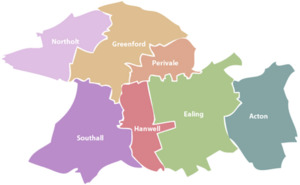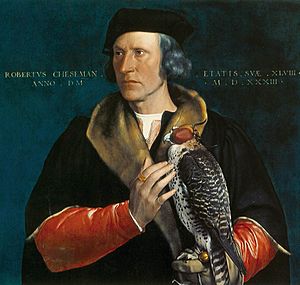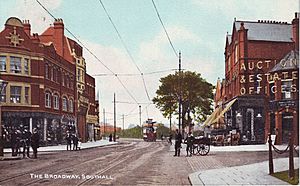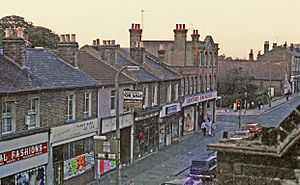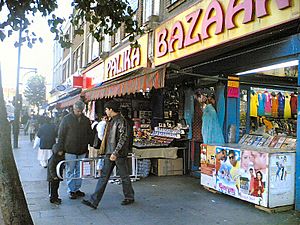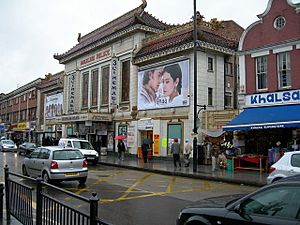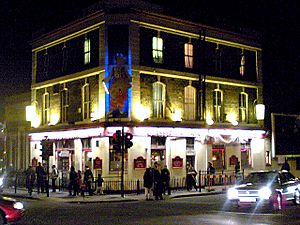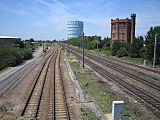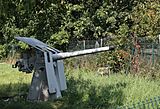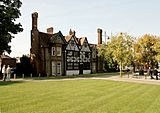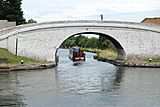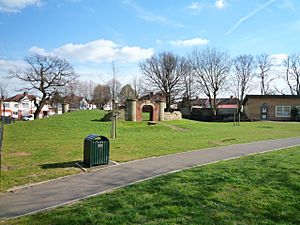Southall facts for kids
Quick facts for kids Southall |
|
|---|---|
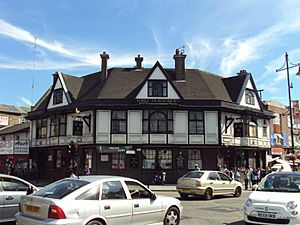 The Three Horseshoes a former pub, once in the centre of Southall |
|
| Population | 78,253 (2021 Census |
| OS grid reference | TQ125805 |
| • Charing Cross | 10.7 mi (17.2 km) Wre |
| London borough | |
| Ceremonial county | Greater London |
| Region | |
| Country | England |
| Sovereign state | United Kingdom |
| Post town | SOUTHALL |
| Postcode district | UB1, UB2 |
| Dialling code | 020 |
| Police | Metropolitan |
| Fire | London |
| Ambulance | London |
| EU Parliament | London |
| UK Parliament |
|
| London Assembly |
|
Southall (/ˈsaʊθɔːl/) is a large town in West London, England. It is part of the London Borough of Ealing and is one of its seven main towns.
Southall is about 17.2 kilometers (10.7 miles) west of Charing Cross, a central point in London. In 2011, its population was 69,857. The town is generally split into three areas. These include a residential area around Lady Margaret Road, the main shopping area called High Street and Southall Broadway, and Old Southall/Southall Green to the south. This southern part includes Southall railway station, factories, and Norwood Green, bordered by the M4.
Historically, Southall was a municipal borough in Middlesex until 1965. The Grand Union Canal (once called the Grand Junction Canal) runs through Southall. This canal was important for connecting London with other growing canal systems. It was used for commercial transport until the 1950s and is still open for boats today. The canal separates Southall from Hayes to the west. To the east, the River Brent separates it from Hanwell.
Starting in the 1950s, many Asian immigrants moved to Southall. They were drawn by local factories and its closeness to Heathrow Airport. The town became home to the largest Punjabi community outside of India. Today, Southall is a major hub for South Asian culture, earning it the nickname Little India.
Contents
What's in a Name? Southall's Origin
The name Southall comes from an old English phrase. æt súð healum means "At the south corner of the land or wood." súð heal means "South corner." This name helped tell it apart from Northolt, which was originally norþ heal or "North corner." Later, norþ heal became linked with holt, meaning "wood" or "copse," leading to the name Northolt.
Southall's name appeared as Suhaull in 1198. It was called Sudhale in 1204. On the Oxfordshire Sheldon tapestry from the late 1580s, it was shown as Southold.
Many other places in Southall have Anglo-Saxon names. These include Elthorne and Waxlow. The earliest record of the area is from 830 AD. It mentions Warberdus giving Norwood Manor and Southall Manor to the archbishops of Charles House.
Southall's Past: A Journey Through Time
Southall was once part of the Norwood area. This was in the ancient parish of Hayes. In 1891, Southall Norwood Local Government District was formed. It became the Southall Norwood Urban District in 1894. In 1936, it became a municipal borough and was renamed Southall. In 1965, Southall joined with Ealing and Acton. Together, they formed the London Borough of Ealing in Greater London.
The southern part of Southall was known as Old Southall or Southall Green. It was centered around the historic Tudor-style Manor House. This building dates back to at least 1587. Much of the building is original. It shows how Southall Green was once a quiet rural village. Today, it is used as offices.
The very south of Southall is called Norwood Green. It is mostly a residential area. For many years, it remained agricultural while the rest of Southall grew with industries. Norwood Green is partly in the London Borough of Hounslow.
The main road through Southall is Uxbridge Road (A4020). In the shopping area, its name changes to The Broadway and then High Street. Uxbridge Road was a main route from London to Oxford for many years. It remained important until the Western Avenue highway was built north of Southall. First, horse-drawn trams, then electric trams, and later electric trolleybuses provided transport. These were replaced by diesel buses in 1960.
Southall in the 1800s: Growth and Industry
The Grand Junction Canal (later Grand Union Canal) opened in 1796. It became a major route for goods between London and Birmingham. This started a commercial boom. The arrival of Brunel's Great Western Railway in 1839 made it even bigger. This led to many brick factories, flour mills, and chemical plants. These formed the town's business base. In 1877, the Martin Brothers started a ceramics factory. They made unique ceramics called Martinware until 1923.
A railway line from Southall railway station to the Brentford Dock on the Thames was also built by Isambard Kingdom Brunel in 1856. It features one of his impressive engineering works, the Three Bridges. Here, Windmill Lane, the railway, and the Grand Union Canal all cross paths. The canal goes over the railway line, and a new road-bridge goes over both. Brunel died soon after it was finished. Another notable local structure by Brunel is the Wharncliffe Viaduct. This carries the Great Western Railway over the River Brent towards London. It was Brunel's first major design.
Otto Monsted, a Danish margarine maker, built a large factory in Southall in 1894. It was called the Maypole Dairy. It became one of the biggest margarine factories in the world. The factory had its own railway lines and canal branch. Later, Lever Brothers bought the Maypole Dairy Company site. As part of Unilever, they turned it into a Wall's Sausages factory. It made sausages and other meat products until the late 1980s.
Southall in the 1900s: Changes and Community
At the start of the 1900s, Southall's old church, St John's, was too small. A new building was finished in 1910. The original church is now a youth centre.
In the 1920s and 1930s, many Welsh people moved to Southall. They were escaping tough economic times in Wales. For many years, Welsh accents were common in the area.
On Southall's eastern border was the Hanwell Asylum. It was once the world's largest hospital for people with mental illness. It was seen as a very good hospital for its time. As care for mental illness improved, it was renamed St. Bernard's Hospital. In the late 1970s, much of the site was rebuilt. Most of it is now Ealing Hospital. St. Bernard's still has a large facility there.
During World War II, Southall was bombed several times. A German V-1 flying bomb destroyed houses in Regina Road. Bomb shelters were built near schools and public buildings. The shelters at Hamborough Primary School were made bigger during the Cold War. They became a control center for London's Civil Defence. This facility is no longer used.
In 1950, the first group of South Asians arrived in Southall. They were reportedly hired to work in a local factory. This South Asian population grew. This was because of new job opportunities, like at Heathrow Airport. The most important cultural group to settle in Southall are Asians. Over 55% of Southall's population is Indian/Pakistani. By 1982, 65% of Southall's residents were of Asian origin.
Important Events and Community Challenges
On September 2, 1958, a plane crashed into houses in Kelvin Gardens. It was a cargo flight from Heathrow Airport. The three crew members and four people on the ground died. A 14-year-old boy, Brian Gibbons, received an award for bravery. The accident was due to poor maintenance.
The 1970s saw some community challenges in the area. In 1976, a Sikh teenager, Gurdip Singh Chaggar, was killed in a racist attack. On April 23, 1979, Blair Peach, a teacher and activist against racism, died during a protest against the National Front. These events led to increased awareness and protests against racism in the community.
On July 4, 1981, a community disturbance happened at the Hambrough Tavern. Young people in the area had heard that some visitors were causing trouble. Over 200 people had traveled from East London. Some of them damaged shops and shouted slogans. In response, about 400 local residents gathered. The situation escalated, leading to injuries and the tavern burning down. This was one of several similar events in Britain that year.
The Southall rail crash happened on September 19, 1997. A high-speed train from Swansea to London Paddington went past a red signal. It crashed into a goods train near Southall railway station. Seven people died and 139 were injured.
Southall's Business Story
The Quaker Oats Company built a factory in Southall in 1936. Part of it, making pet foods, was sold in 1994. The rest was sold in 2006. The site still makes brands like Honey Monster Puffs. Other factories, making things like paint and food, also did well for many years. Most were near the railway or canal.
A collection of Martinware – special pottery and bird figures – is on display at Southall Library.
Southall was home to Southall Studios, one of Britain's first film studios. It was important for filmmaking from 1924 to 1959. In 1936, a fire destroyed the studio, but it was rebuilt. Many films and early TV shows were made there.
There has been a locomotive works at the Southall Depot for almost 150 years. It was once a Great Western Railway shed. It might have been the last steam depot in London. Today, the site is called the Southall Railway Centre. It is used by two groups: Locomotive Services Limited and West Coast Railways.
The bus and vehicle maker Associated Equipment Company (AEC) was based in Southall. It moved there in 1926 and closed in 1979. The site was known for its large signs saying "AEC – Builders of London's Buses for 50 years."
A large gas works was located between the railway and the canal. In 1932, a big gasholder was built. It was a local landmark until it was taken down in 2019. The letters 'LH' and an arrow were painted on it. These helped pilots find Heathrow Airport's runway 23. Since town gas production stopped in the 1970s, much of the site has been empty.
Southall's Culture: A Vibrant Community
Since World War II, Southall has become a largely South Asian area. It is sometimes called "Little India".
The main railway station signs are in both English and Gurmukhi. Gurmukhi is a written form of Punjabi. The main street in Southall is The Broadway. A smaller shopping area is on King Street in Old Southall. Southall has one of the biggest South Asian shopping areas in the region. It is similar to Green Street in East London or Ealing Road in Wembley.
Southall is home to London's largest Sikh community. There are ten Sikh Gurdwaras (temples) in Southall. The Gurdwara Sri Guru Singh Sabha, opened in 2003, is one of the largest Sikh gurdwaras outside India. It won an architectural award in 2003. There are also two large Hindu 'Mandir' temples. These are the Vishnu Hindu Mandir and the Ram Mandir. Southall also has more than ten Christian churches and six Mosques 'Masjids'.
The Tudor Rose, Southall is a nightclub and venue. It serves the local British African-Caribbean community. It opened as a cinema in 1910 and became a club in 1983.
Another notable local pub was The Three Horseshoes in Southall Broadway. It closed in 2017.
Media and Entertainment in Southall
There are two local community radio stations in Southall. Westside 89.6 FM plays urban music. Desi Radio mostly broadcasts in Punjabi. Sunrise Radio, for the wider Asian community, was also based in Southall.
Some non-English newspapers are also available. Des Pardes is a Punjabi-language paper.
Southall was the main setting for the film Bend It Like Beckham.
Southall also had the Glassy Junction public house. It was the first pub in the UK to accept Indian Rupees as payment. The Glassy Junction closed in 2011. It has been replaced by the restaurant chain, Saravana Bhavan.
Southall has also appeared in other Bollywood films. These include Patiala House and Goal!.
Sports and Recreation in Southall
The local football club, Southall F.C., started in 1871. Famous players like Les Ferdinand played there. As of 2018–19, they play in the Premier Division of the Combined Counties Football League. The local cricket club is London Tigers CC. They play at Spikes Bridge Park. Southall Park hosts a free weekly 5k park run every Saturday.
Famous Faces from Southall
Many talented people have come from Southall.
Musicians from Southall
- H Dhami, Bhangra singer
- Channi Singh OBE, known as the "godfather of bhangra"
- Ms Scandalous, rapper/MC, born in Southall in 1983
- Juggy D, bhangra singer
- Cleo Laine, jazz singer and actress, born in Southall in 1927
- Rishi Rich, music producer
- Misty in Roots, reggae band, started in the early 1970s
- Jay Sean (Kamaljeet Singh Jhooti), R&B singer, grew up here
- Kuljit Bhamra MBE, composer and producer, educated at Villiers High School
- The Ruts, punk band from the late 1970s
- Ian D'Sa, guitarist of punk rock band Billy Talent
- Ray Dorset, singer of British rock group Mungo Jerry
- Panjabi Hit Squad, Dj, Producers and artists
- Ash King, Singer
Writers from Southall
- Mike Ashley, author and editor
- Kwame Kwei-Armah, playwright and actor
- Rupinderpal Singh Dhillon, poet
- Tim Lott, author, born here in 1956
- Harjeet Atwal, author
- Amarjit Chandan poet and translator
Television and Film Personalities
- Daljit Dhaliwal, newsreader and journalist
- Nick Knowles, television personality
- Joseph Marcell, American television actor ("Fresh Prince of Bel Air")
- Actress Hayley Mills lived in Norwood Green, Southall
- Gurinder Chadha OBE, film director, often sets her films about the British Asian community in Southall
- Stewart Bevan, actor and screenwriter, grew up in Southall
- Elisabeth Sladen, British Actress, lived in Southall
Political Figures
- Sir Leslie Murphy (1915–2007) was born in Southall. He became a successful businessman and civil servant. He was knighted in 1978.
- Syd Bidwell represented Southall in parliament from 1966 to 1992. He was followed by Piara Khabra and then Virendra Sharma.
Other Notable People
- Les Ferdinand, England footballer, played for Southall FC.
- Paul Canoville, English footballer, first black player for Chelsea F.C.
- Brett Ewins, comic book artist.
- Trevor Baylis OBE, inventor of the Clockwork Radio, grew up here.
- Carole Middleton, mother of The Duchess of Cambridge, lived here as a child.
Southall's Special Places and Landmarks
- Wharncliffe Viaduct. A large structure, 274 meters (300 yards) long and 20 meters (65 feet) high. It is on the north side of Uxbridge Road.
- Manor House, The Green, Southall, UB2 4BJ
- Southall Town Hall
- Isambard Kingdom Brunel's Three Bridges
- Golf Links Estate. A housing area from the 1960s.
- Gurdwara Sri Guru Singh Sabha. The largest Sikh gurdwara (temple) outside Asia.
- Landmarks of Southall
-
Redbrick water tower (now converted into apartments) with the former Southall Gas Works gasholder behind
-
A naval gun that was at the Threebridges, Former part of the Outer London Defence Ring
-
Bull's Bridge, Grand Union Canal (between Southall and Hayes)
Southall's Location and How to Get Around
 |
Yeading | Greenford, Northolt | Greenford, Hanwell |  |
| Hayes | Hanwell | |||
The Broadway/Lady Margaret Road/High Street/South Road |
||||
| Hayes | North Hyde/Norwood Green, Heston, Hounslow | Norwood Green, Osterley |
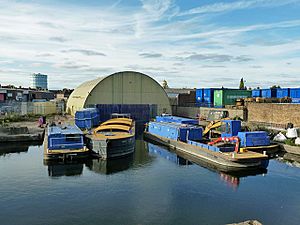
Nearby places include Hayes, Hanwell, Hounslow, Greenford, Northolt and Ealing. Southall is recognized as one of the 35 major centers in Greater London.
Southall has its own railway station on the Great Western Main Line. This connects it to Heathrow Airport, Reading, Oxford, and London Paddington.
The closest London Underground station to the town center is Osterley station. It is on the Piccadilly line and is about 3.2 kilometers (2 miles) south.
Frequent bus services connect Southall to all nearby areas and Heathrow Airport.
There is also an express coach service between Southall, Leicester, and Birmingham. This service is popular with families who have connections in these areas' South Asian populations.
Schools in Southall
- Villiers High School
- Dormers Wells High School
- Ealing, Hammersmith and West London College, a campus is located on Beaconsfield Road in Southall.
- Featherstone High School
- Ayesha Siddiqa Girls School, located in the Abu Bakr Mosque
See also
 In Spanish: Southall para niños
In Spanish: Southall para niños



